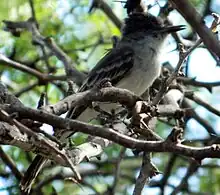Caribbean elaenia
The Caribbean elaenia (Elaenia martinica) is a species of bird in the family Tyrannidae found in the West Indies and parts of Central America. Its natural habitats are tropical and subtropical dry broadleaf forest, subtropical or tropical moist lowland forest, and heavily degraded former forest.
| Caribbean elaenia | |
|---|---|
 | |
| Scientific classification | |
| Domain: | Eukaryota |
| Kingdom: | Animalia |
| Phylum: | Chordata |
| Clade: | Dinosauria |
| Class: | Aves |
| Order: | Passeriformes |
| Family: | Tyrannidae |
| Genus: | Elaenia |
| Species: | E. martinica |
| Binomial name | |
| Elaenia martinica (Linnaeus, 1766) | |
| Subspecies | |
|
See text | |
 | |
| Synonyms | |
|
Muscicapa martinica Linnaeus, 1766 | |
Taxonomy
In 1760 the French zoologist Mathurin Jacques Brisson included a description of the Caribbean elaenia in his Ornithologie based on a specimen collected on the island of Martinique. He used the French name Le gobe-mouche hupé de la Martinique and the Latin Muscicapa Martinicana cristata.[2] Although Brisson coined Latin names, these do not conform to the binomial system and are not recognised by the International Commission on Zoological Nomenclature.[3] When in 1766 the Swedish naturalist Carl Linnaeus updated his Systema Naturae for the twelfth edition, he added 240 species that had been previously described by Brisson.[3] One of these was the Caribbean elaenia. Linnaeus included a brief description, coined the binomial name Muscicapa martinica and cited Brisson's work.[4] This species is now placed in the genus Elaenia that was introduced by the Swedish zoologist Carl Jakob Sundevall in 1836.[5]
Seven subspecies are recognized:[6]
- Elaenia martinica riisii Sclater, 1860 - Puerto Rico, Virgin Is., Anguilla, St. Martin, St. Bartholomew, Antigua and Barbuda, and Netherlands Antilles
- Elaenia martinica martinica (Linnaeus, 1766) - Lesser Antilles
- Elaenia martinica barbadensis Cory, 1888 - Barbados
- Elaenia martinica remota von Berlepsch, 1907 - (San Andrés and Providencia)
- Elaenia martinica chinchorrensis Griscom, 1926 - Great Cay Island (off eastern Mexico) and nearby cays
- Elaenia martinica cinerescens Ridgway, 1884 - Islands off Honduras
- Elaenia martinica caymanensis von Berlepsch, 1907 - Cayman Islands
Its natural habitats are tropical and subtropical dry broadleaf forests, subtropical or tropical moist lowland forest, and heavily degraded former forest.

References
- BirdLife International (2017). "Elaenia martinica". IUCN Red List of Threatened Species. 2017: e.T22699259A118642306. doi:10.2305/IUCN.UK.2017-3.RLTS.T22699259A118642306.en. Retrieved 11 November 2021.
- Brisson, Mathurin Jacques (1760). Ornithologie, ou, Méthode contenant la division des oiseaux en ordres, sections, genres, especes & leurs variétés (in French and Latin). Vol. 2. Paris: Jean-Baptiste Bauche. pp. 362–363, Plate 36 fig 2. The two stars (**) at the start of the section indicates that Brisson based his description on the examination of a specimen.
- Allen, J.A. (1910). "Collation of Brisson's genera of birds with those of Linnaeus". Bulletin of the American Museum of Natural History. 28: 317–335. hdl:2246/678.
- Linnaeus, Carl (1766). Systema naturae : per regna tria natura, secundum classes, ordines, genera, species, cum characteribus, differentiis, synonymis, locis (in Latin). Vol. 1, Part 1 (12th ed.). Holmiae (Stockholm): Laurentii Salvii. p. 325.
- Sundevall, Carl Jakob (1836). "Elaenia". Kungl. Svenska Vetenskapsakademiens Handlingar. series 3 (in Latin). 23: 89.
- Gill, Frank; Donsker, David, eds. (2018). "Tyrant flycatchers". World Bird List Version 8.2. International Ornithologists' Union. Retrieved 1 July 2018.
External links
- Stamps (for Anguilla, Antigua and Barbuda, Barbados, Barbuda, Cayman Islands, Montserrat, Saint Kitts and Nevis, and Saint Lucia)
- Stamp photo
- Caribbean elaenia photo gallery VIREO; Photo-linked at natureserve.org
